Cutting Force Estimation Using Milling Spindle Vibration-Based Machine Learning
Abstract
1. Introduction
2. Relationship Between Tool Wear and Cutting Force
2.1. Machining Experiments
2.2. Effect of Tool Wear on Cutting Force
3. Cutting Force Estimation Using LSTM-Based Time-Series Machine Learning
3.1. LSTM-Based Time-Series Machine Learning
3.2. LSTM Architecture for Cutting Force Estimation
4. Training and Analysis of Cutting Force Estimation
5. Conclusions
Author Contributions
Funding
Data Availability Statement
Conflicts of Interest
References
- Byrne, G.; Dornfeld, D.; Inasaki, I.; Ketteler, G.; König, W.; Teti, R. Tool condition monitoring (TCM)—The status of research and industrial application. CIRP Ann. 1995, 44, 541–567. [Google Scholar] [CrossRef]
- de Leon, M.A.L.; Kolarik, J.; Byrtus, R.; Koziorek, J.; Zmij, P.; Martinek, R. Tool condition monitoring methods applicable in the metalworking process. Arch. Comput. Methods Eng. 2024, 31, 221–242. [Google Scholar] [CrossRef]
- Siddhpura, A.; Paurobally, R. A review of flank wear prediction methods for tool condition monitoring in a turning process. Int. J. Adv. Manuf. Technol. 2013, 65, 371–393. [Google Scholar] [CrossRef]
- Audy, J. An appraisal of techniques and equipment for cutting force measurement. J. Zhejiang Univ. A 2006, 7, 1781–1789. [Google Scholar] [CrossRef]
- Hanif, M.I.; Aamir, M.; Ahmed, N.; Maqsood, S.; Muhammad, R.; Akhtar, R.; Hussain, I. Optimization of facing process by indigenously developed force dynamometer. Int. J. Adv. Manuf. Technol. 2019, 100, 1893–1905. [Google Scholar] [CrossRef]
- Qin, Y.; Zhao, Y.; Li, Y.; Zhao, Y.; Wang, P. A novel dynamometer for monitoring milling process. Int. J. Adv. Manuf. Technol. 2017, 92, 2535–2543. [Google Scholar] [CrossRef]
- Raheem, A.; Khan, R.; Mazhar, A.R.; Ya, H.H.; Alam, M.A.; Ahmed, T.; Azeem, M. A review of recent studies of dynamometers for cutting force measurement in machining processes. In Proceedings of the International Conference on Robotics and Automation in Industry, Rawalpindi, Pakistan, 26–27 October 2021; pp. 1–7. [Google Scholar] [CrossRef]
- Zhou, Y.; Sun, W. Tool wear condition monitoring in milling process based on current sensors. IEEE Access 2020, 8, 95491–95502. [Google Scholar] [CrossRef]
- Li, X.; Djordjevich, A.; Venuvinod, P. Current-sensor-based feed cutting force intelligent estimation and tool wear condition monitoring. IEEE Trans. Ind. Electron. 2000, 47, 697–702. [Google Scholar] [CrossRef]
- Yuan, J.; Liu, L.; Yang, Z.; Bo, J.; Zhang, Y. Tool wear condition monitoring by combining spindle motor current signal analysis and machined surface image processing. Int. J. Adv. Manuf. Technol. 2021, 116, 2697–2709. [Google Scholar] [CrossRef]
- Lin, X.; Zhou, B.; Zhu, L. Sequential spindle current-based tool condition monitoring with support vector classifier for milling process. Int. J. Adv. Manuf. Technol. 2017, 92, 3319–3328. [Google Scholar] [CrossRef]
- Li, X. A brief review: Acoustic emission method for tool wear monitoring during turning. Int. J. Mach. Tools Manuf. 2002, 42, 157–165. [Google Scholar] [CrossRef]
- Jemielniak, K.; Kossakowska, J. Tool wear monitoring based on wavelet transform of raw acoustic emission signal. Adv. Manuf. Sci. Technol. 2010, 34, 5–16. [Google Scholar]
- Hase, A.; Wada, M.; Koga, T.; Mishina, H. The relationship between acoustic emission signals and cutting phenomena in turning process. Int. J. Adv. Manuf. Technol. 2014, 70, 947–955. [Google Scholar] [CrossRef]
- Kishawy, H.A.; Hegab, H.; Umer, U.; Mohany, A. Application of acoustic emissions in machining processes: Analysis and critical review. Int. J. Adv. Manuf. Technol. 2018, 98, 1391–1407. [Google Scholar] [CrossRef]
- Sun, X. Milling tool condition monitoring based on an integrated wireless vibration sensing tool holder. Int. J. Precis. Eng. Manuf. 2024, 25, 2611–2623. [Google Scholar] [CrossRef]
- Arslan, H.; Er, A.O.; Orhan, S.; Aslan, E. Tool condition monitoring in turning using statistical parameters of vibration signal. Int. J. Acoust. Vib. 2016, 21, 371–378. [Google Scholar] [CrossRef]
- Yesilyurt, I.; Ozturk, H. Tool condition monitoring in milling using vibration analysis. Int. J. Prod. Res. 2007, 45, 1013–1028. [Google Scholar] [CrossRef]
- Kaliyannan, D.; Thangamuthu, M.; Pradeep, P.; Gnansekaran, S.; Rakkiyannan, J.; Pramanik, A. Tool Condition Monitoring in the Milling Process Using Deep Learning and Reinforcement Learning. J. Sens. Actuator Netw. 2024, 13, 42. [Google Scholar] [CrossRef]
- Caggiano, A.; Mattera, G.; Nele, L. Smart Tool Wear Monitoring of CFRP/CFRP Stack Drilling Using Autoencoders and Memory-Based Neural Networks. Appl. Sci. 2023, 13, 3307. [Google Scholar] [CrossRef]
- Turšič, N.; Klančnik, S. Tool Condition Monitoring Using Machine Tool Spindle Current and Long Short-Term Memory Neural Network Model Analysis. Sensors 2024, 24, 2490. [Google Scholar] [CrossRef]
- Lin, Y.-C.; Wu, K.-D.; Shih, W.-C.; Hsu, P.-K.; Hung, J.-P. Prediction of Surface Roughness Based on Cutting Parameters and Machining Vibration in End Milling Using Regression Method and Artificial Neural Network. Appl. Sci. 2020, 10, 3941. [Google Scholar] [CrossRef]
- Wang, Z.; Zhao, Y.; Yao, J.; Yu, T.; Qu, S.; Zhao, J. The Investigation of Graphene Oxide-Enhanced Hybrid Slurry Preparation and Its Polishing Characteristic on CVD Single Crystal Diamond. Materials 2024, 17, 6053. [Google Scholar] [CrossRef] [PubMed]
- Hochreiter, S.; Schmidhuber, J. Long short-term memory. Neural Comput. 1997, 9, 1735–1780. [Google Scholar] [CrossRef] [PubMed]
- Zhang, J.; Zeng, Y.; Starly, B. Recurrent neural networks with long term temporal dependencies in machine tool wear diagnosis and prognosis. SN Appl. Sci. 2021, 3, 442. [Google Scholar] [CrossRef]
- Coto-Jiménez, M. Robustness of LSTM neural networks for the enhancement of spectral parameters in noisy speech signals. In Advances in Computational Intelligence: MICAI 2018 Proceedings, Part II; Batyrshin, I., Martínez-Villaseñor, M., Ponce Espinosa, H., Eds.; Springer: Cham, Switzerland, 2018; pp. 227–238. [Google Scholar] [CrossRef]
- Zhu, M.; Zhang, J.; Bu, L.; Nie, S.; Bai, Y.; Zhao, Y.; Mei, N. Methodology and experimental verification for predicting the remaining useful life of milling cutters based on hybrid CNN-LSTM-Attention-PSA. Machines 2024, 12, 752. [Google Scholar] [CrossRef]
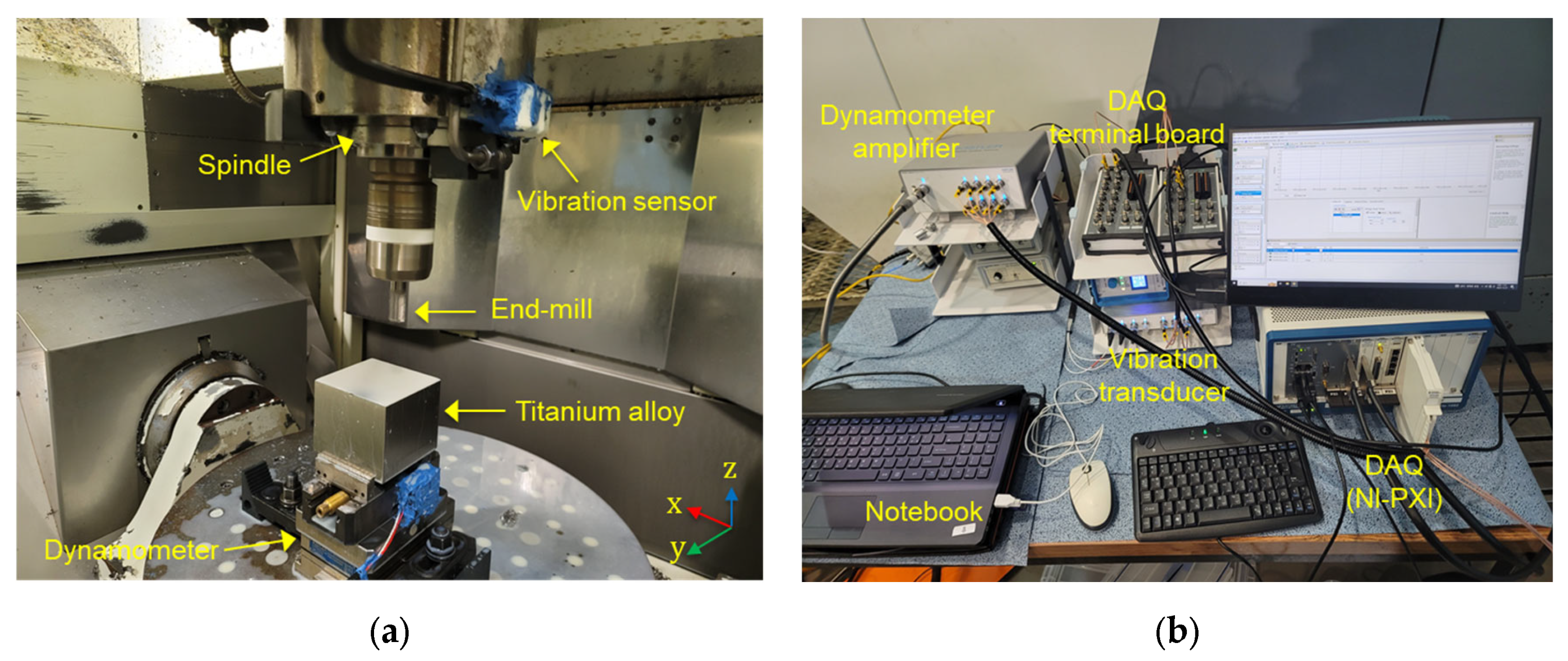
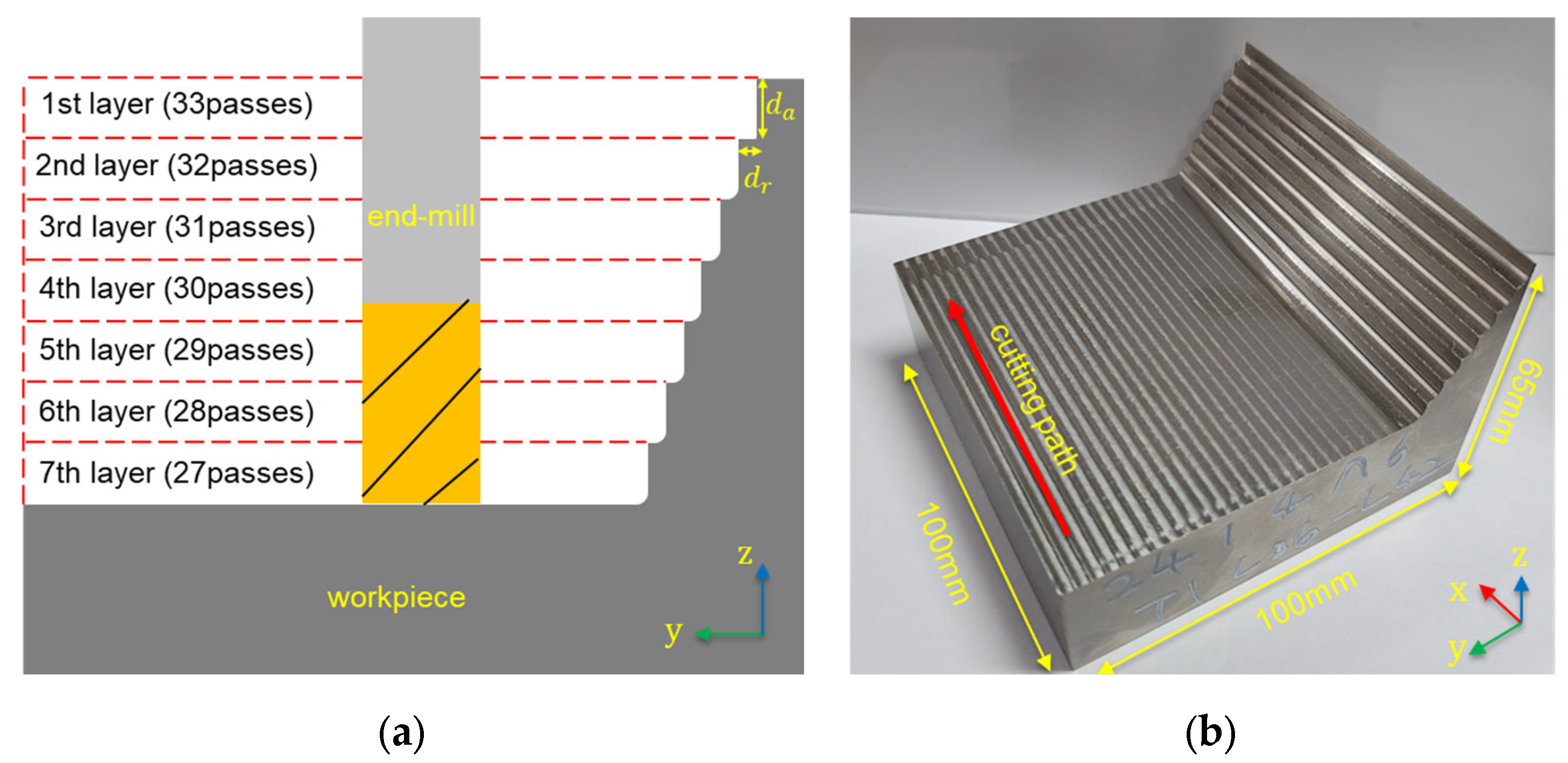
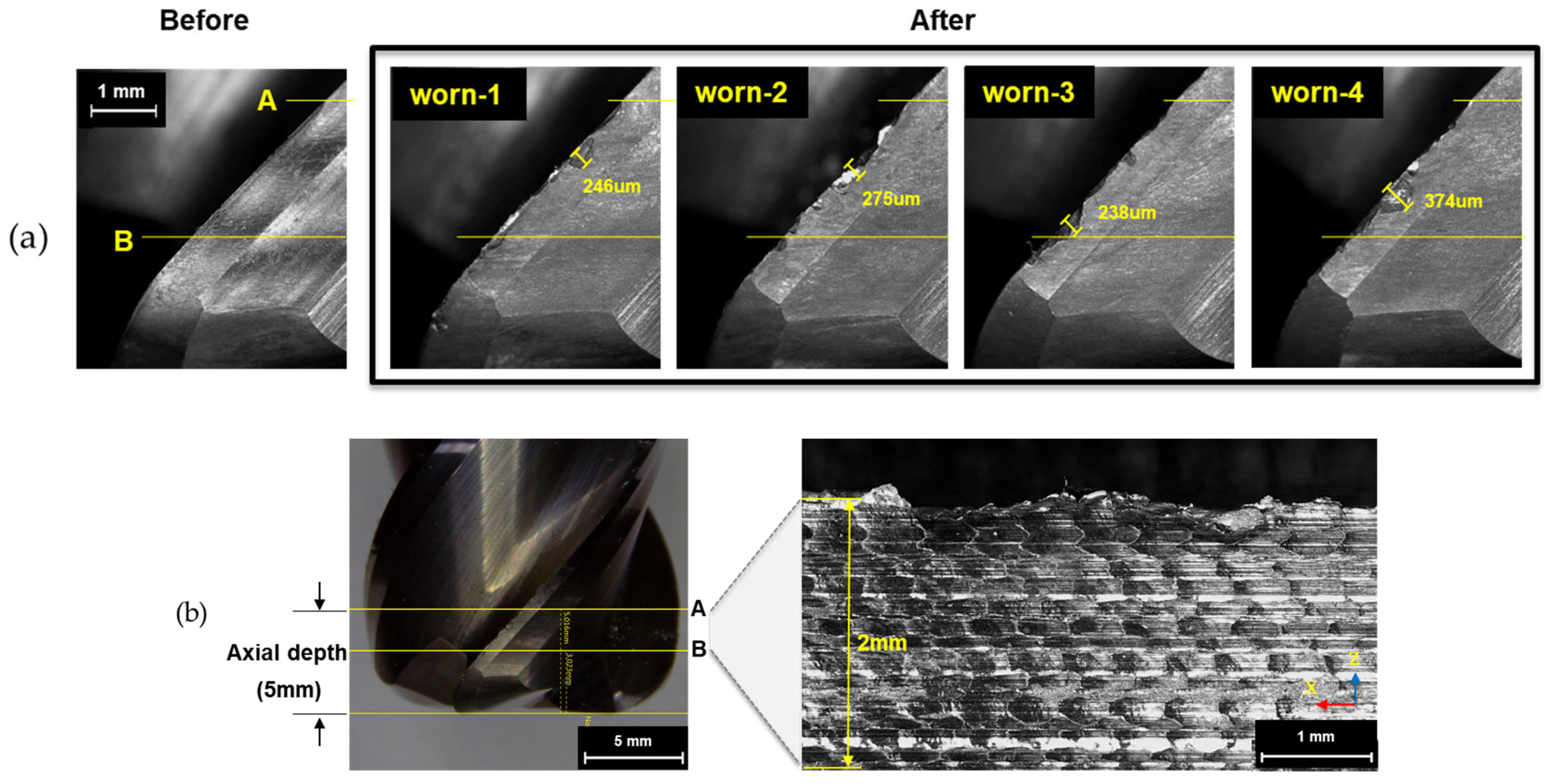



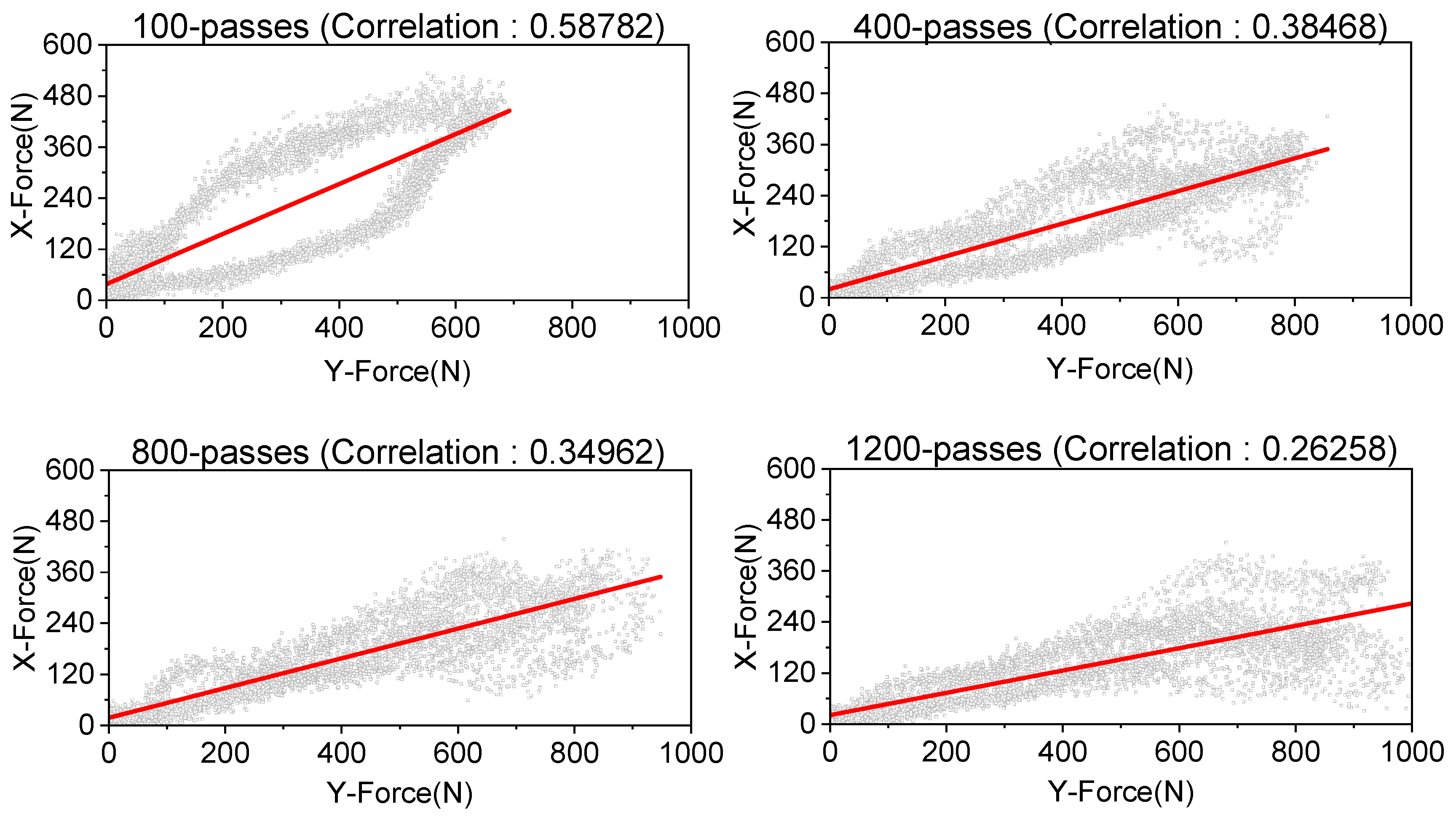
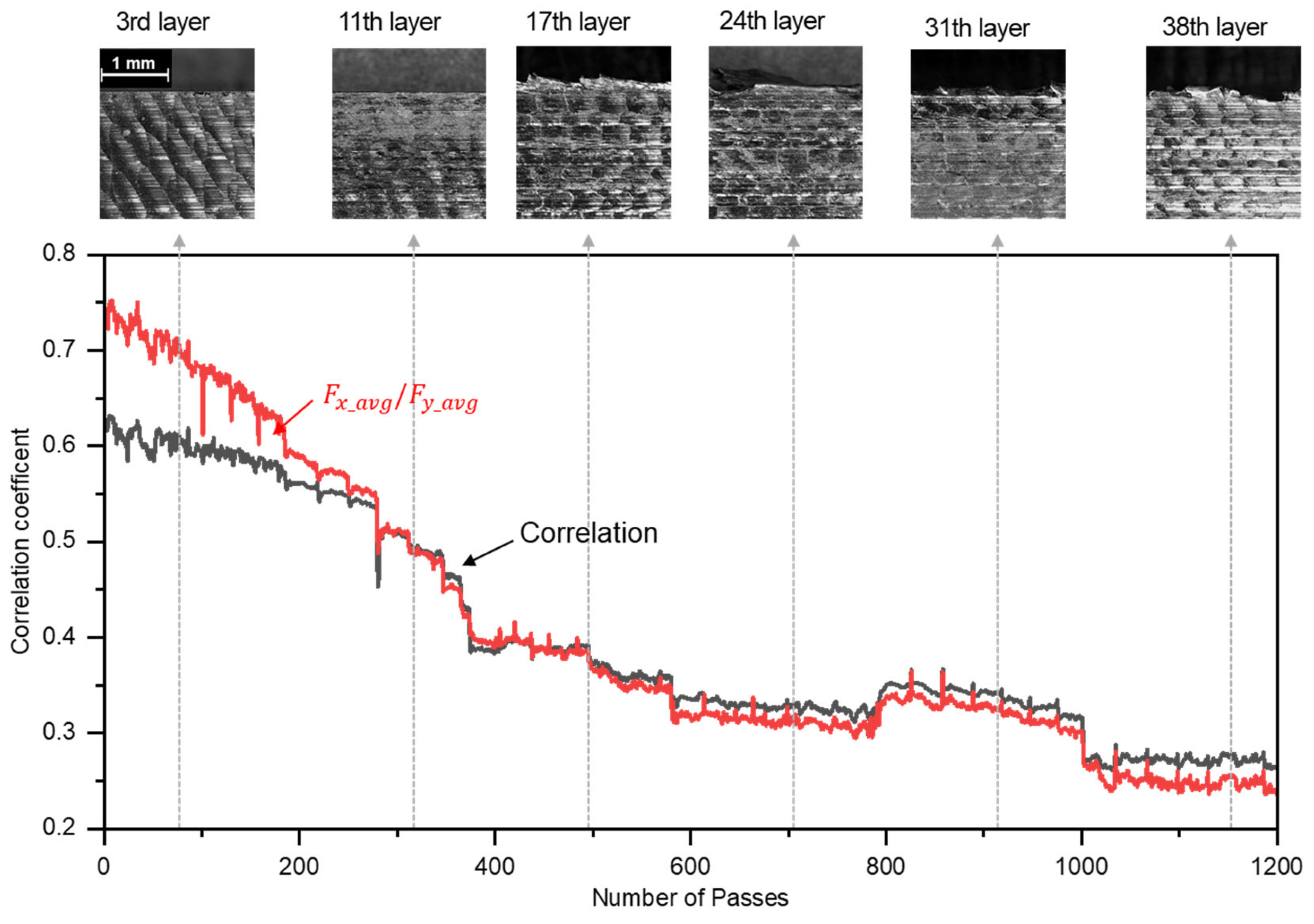

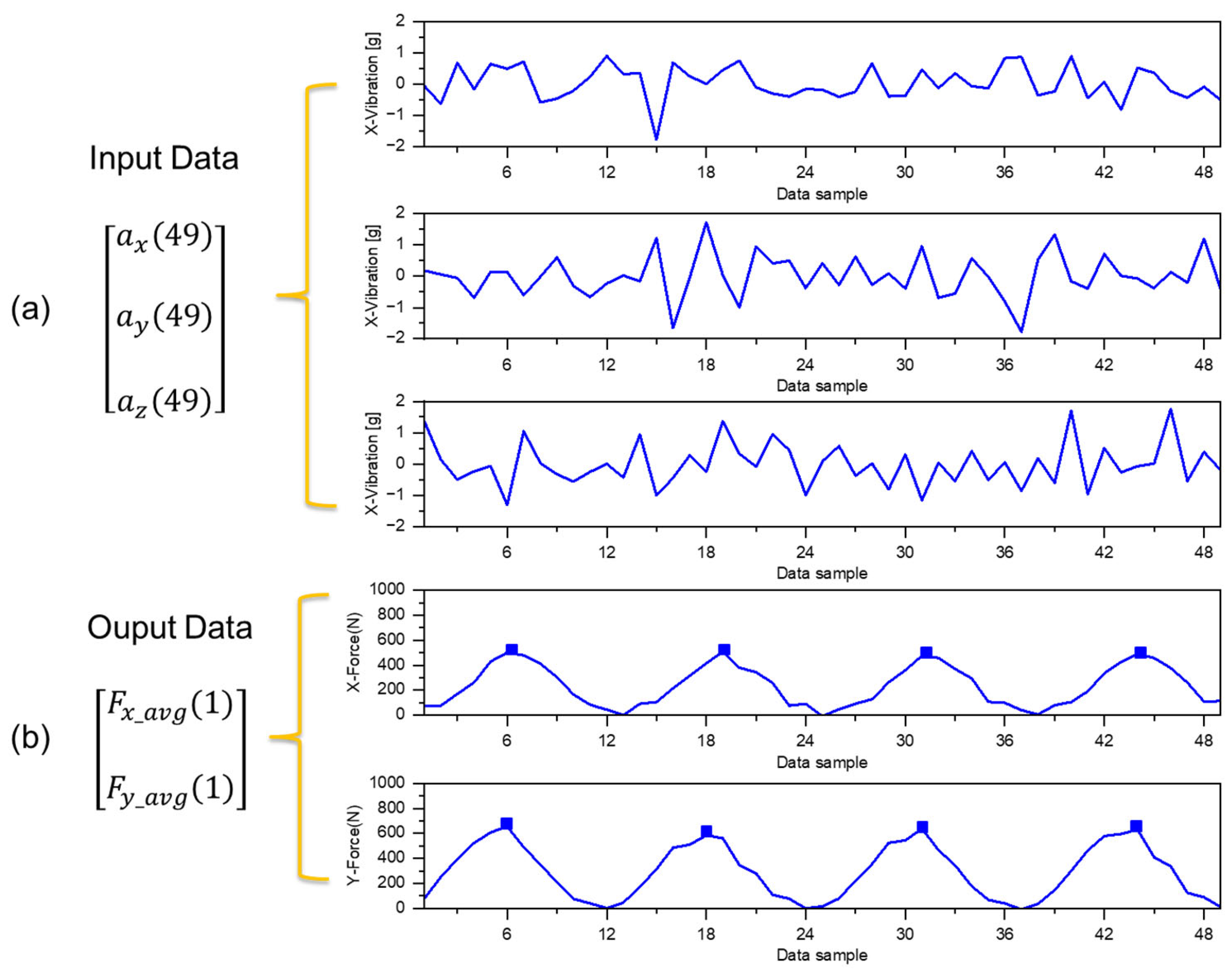
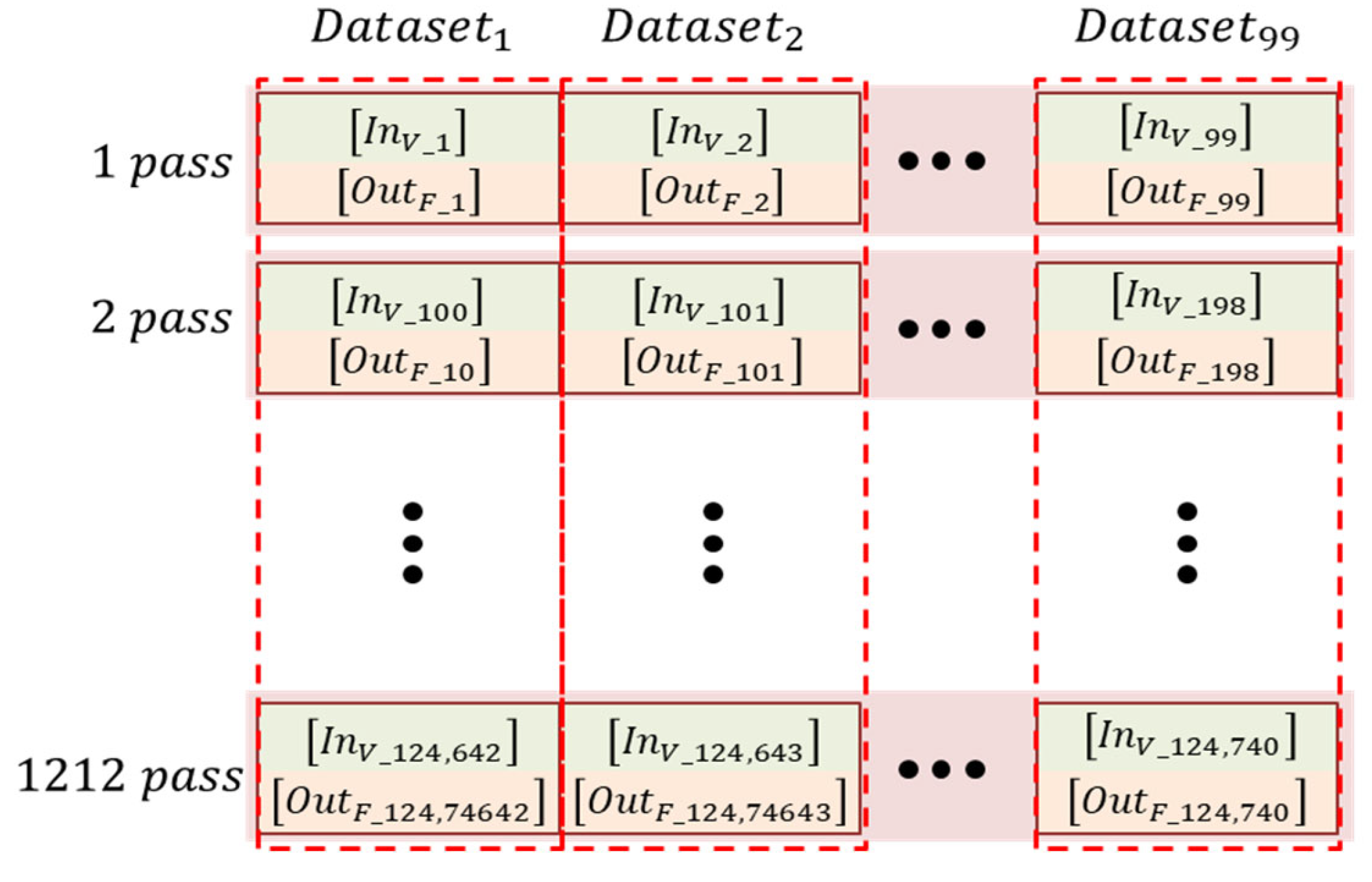

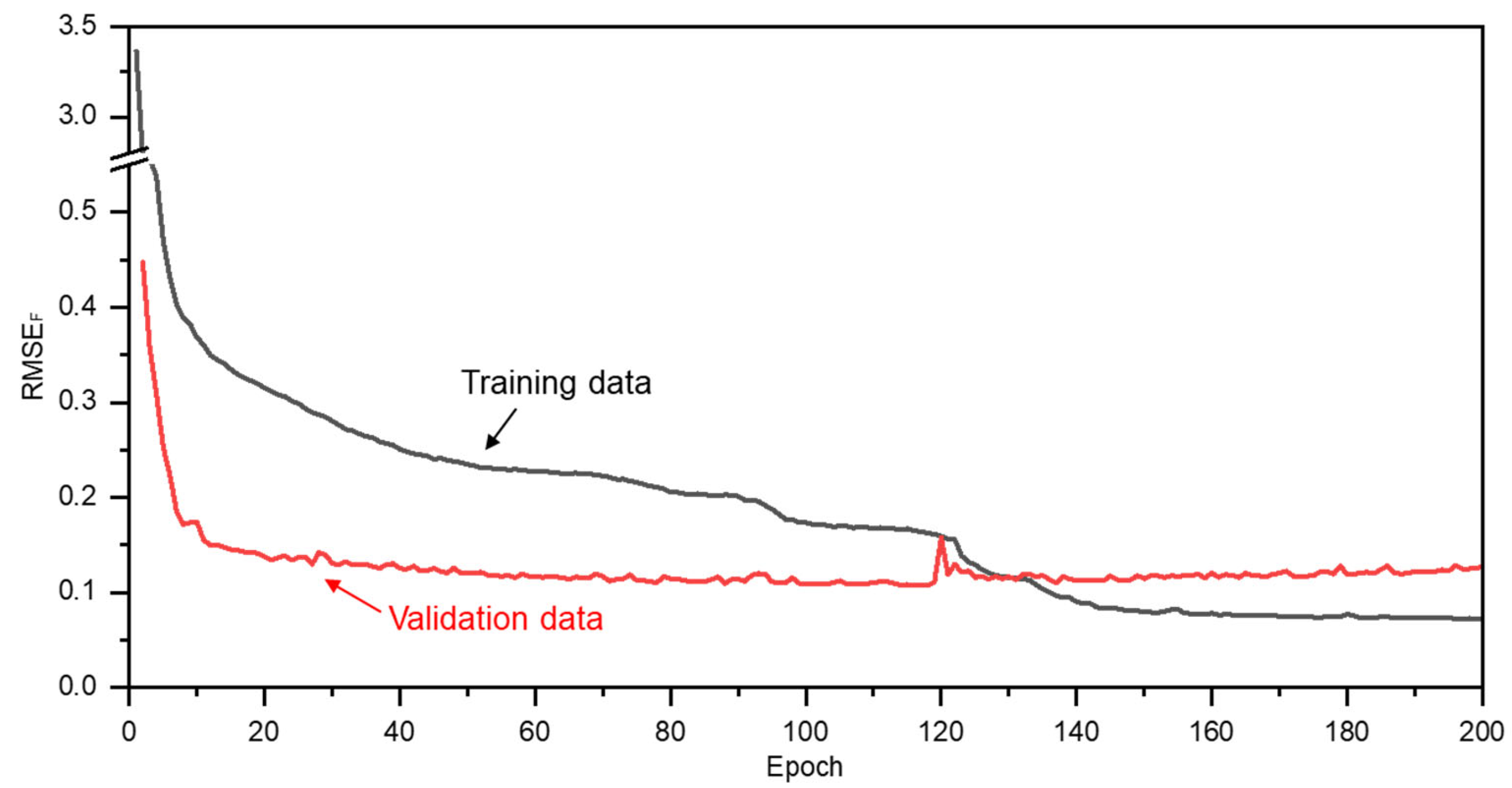
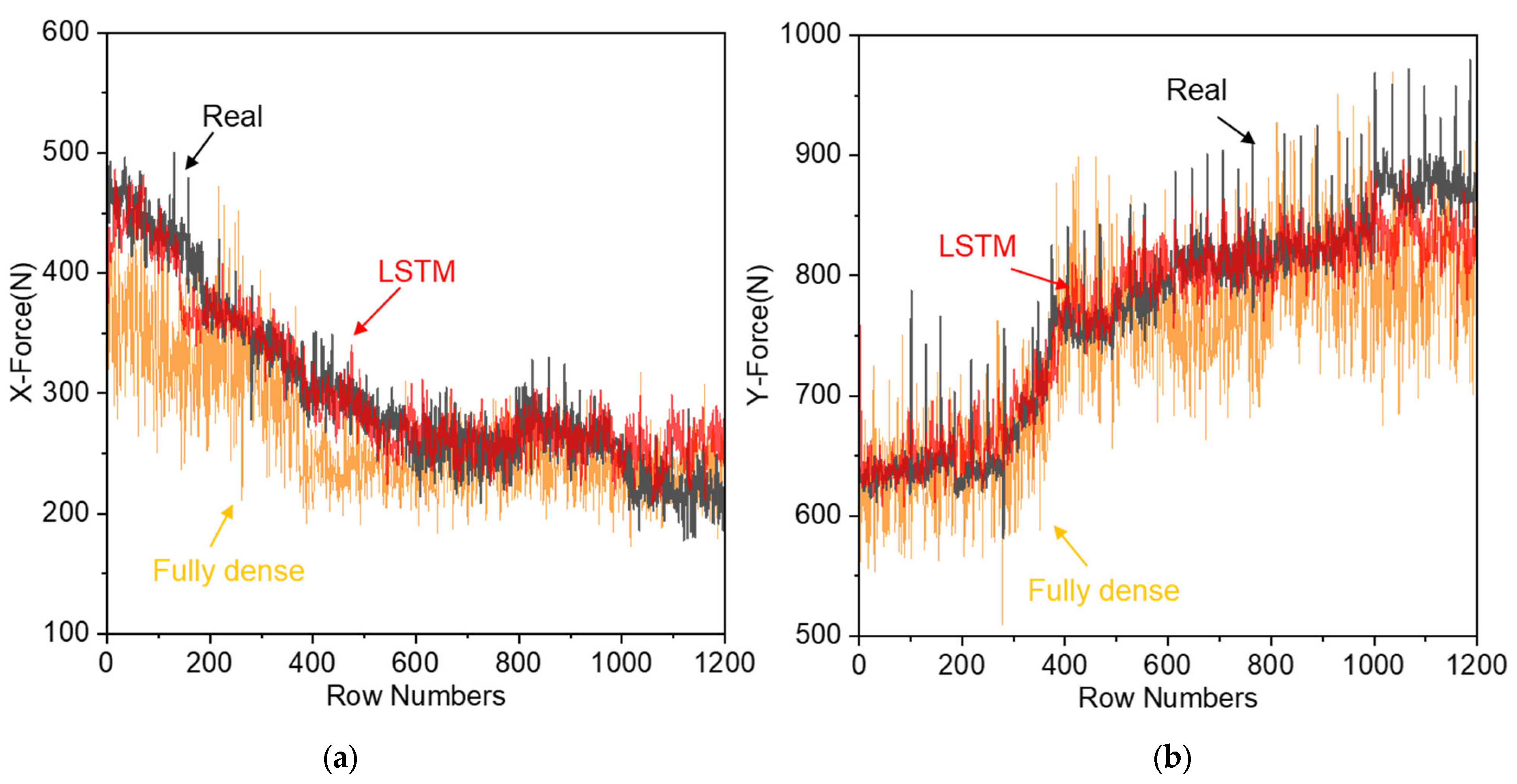

| List | Specifications | ||
|---|---|---|---|
| Dynamometer (9257B & 5167A81 Kistler, Winterthur, Switzerland) | Range Fx, Fy | kN | −5~5 |
| Sensitivity | pC/N | −7.5 | |
| Analog output | V | −10~10 | |
| Vibration sensor (8688A10 & 5134B, Kistler) | Range | g | −10~10 |
| Sensitivity | mV/g | 500 | |
| Analog output | V | −5~5 | |
| Data acquisition (DAQ) (PXIe-1092 & PXIe-6363, NI, Austin, TX, USA) | Analog input | V | −10~10 |
| ADC resolution | bit | 16 | |
| Sample rate | Sample/s | Max 2M | |
| List | Specifications | ||
|---|---|---|---|
| Machining center (Mytrunnion-5G, Kitamura, Toyama-ken, Japan) | Spindle Speed | rpm | 20~20,000 |
| Travel (X, Y, Z) | mm | 815 × 745 × 500 | |
| Accuracy | um | 0.99/Full Stroke | |
| Endmill (Tool) (WALTER, Tübingen, Germany) | Tool diameter | mm | 16, |
| Number of teeth | 4 | ||
| Corner radius | mm | 3 | |
| Workpiece | Materials | Ti-6Al-4V | |
| Size | mm | 100 × 100 × 65 | |
| Machining condition | Radial depth | mm | 3 |
| Axial depth | mm | 5 | |
| Cutting speed | m/min | 60 | |
| Feed per tooth | mm/teeth | 0.12 | |
Disclaimer/Publisher’s Note: The statements, opinions and data contained in all publications are solely those of the individual author(s) and contributor(s) and not of MDPI and/or the editor(s). MDPI and/or the editor(s) disclaim responsibility for any injury to people or property resulting from any ideas, methods, instructions or products referred to in the content. |
© 2025 by the authors. Licensee MDPI, Basel, Switzerland. This article is an open access article distributed under the terms and conditions of the Creative Commons Attribution (CC BY) license (https://creativecommons.org/licenses/by/4.0/).
Share and Cite
Ryu, J.-D.; Lee, H.-H.; Ha, K.-N.; Kim, S.-R.; Lee, M.C. Cutting Force Estimation Using Milling Spindle Vibration-Based Machine Learning. Appl. Sci. 2025, 15, 2336. https://doi.org/10.3390/app15052336
Ryu J-D, Lee H-H, Ha K-N, Kim S-R, Lee MC. Cutting Force Estimation Using Milling Spindle Vibration-Based Machine Learning. Applied Sciences. 2025; 15(5):2336. https://doi.org/10.3390/app15052336
Chicago/Turabian StyleRyu, Je-Doo, Hoon-Hee Lee, Kyoung-Nam Ha, Sung-Ryul Kim, and Min Cheol Lee. 2025. "Cutting Force Estimation Using Milling Spindle Vibration-Based Machine Learning" Applied Sciences 15, no. 5: 2336. https://doi.org/10.3390/app15052336
APA StyleRyu, J.-D., Lee, H.-H., Ha, K.-N., Kim, S.-R., & Lee, M. C. (2025). Cutting Force Estimation Using Milling Spindle Vibration-Based Machine Learning. Applied Sciences, 15(5), 2336. https://doi.org/10.3390/app15052336







